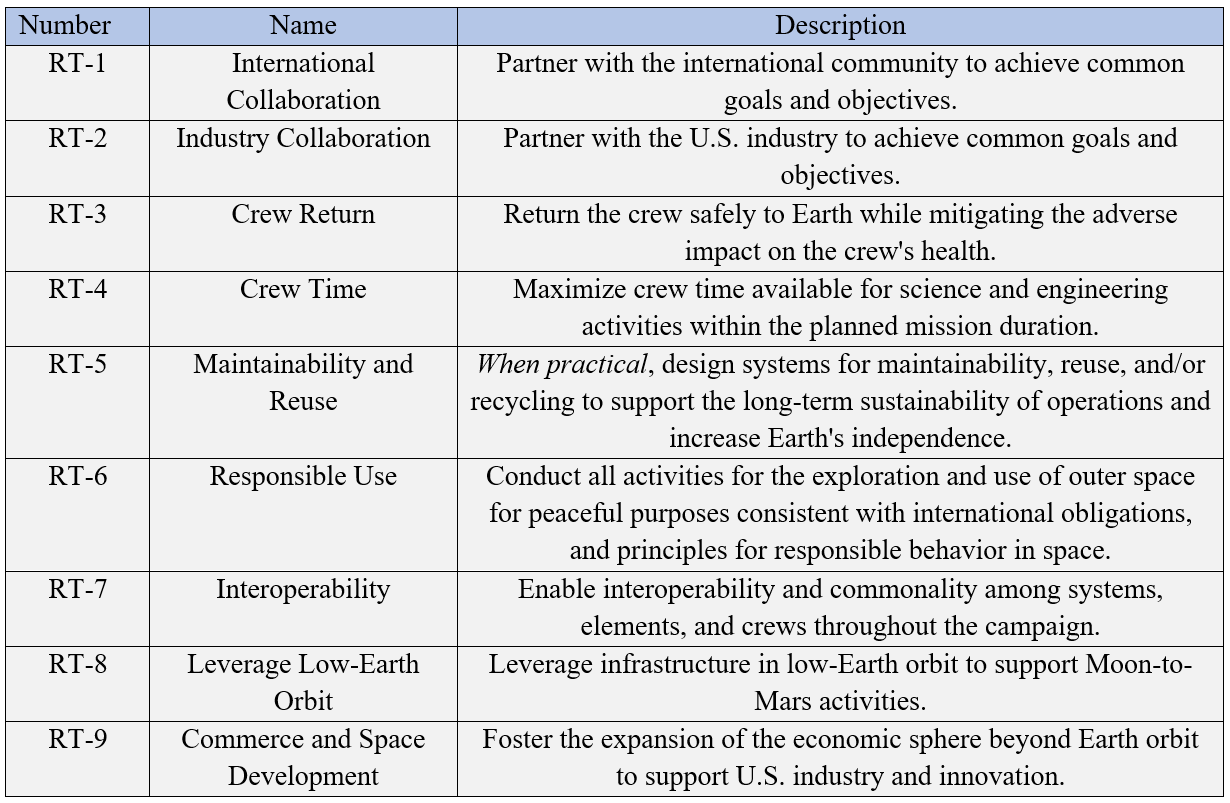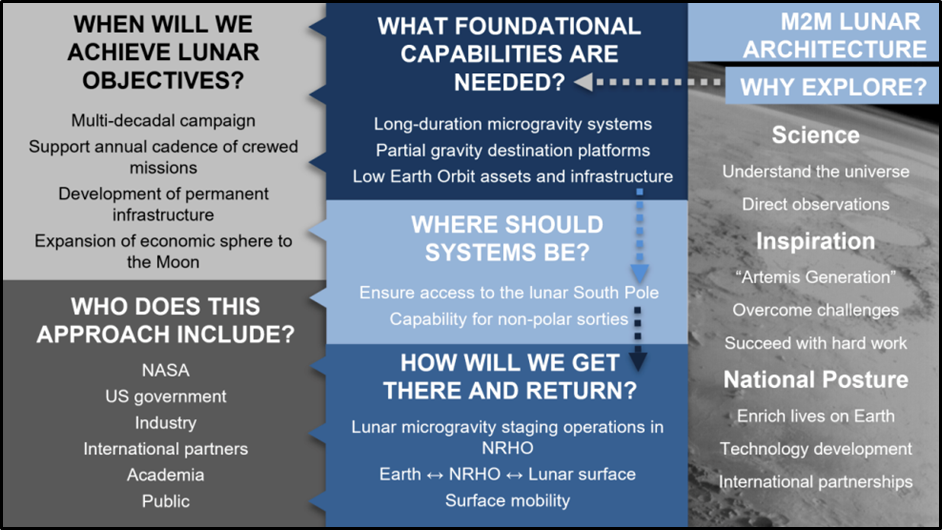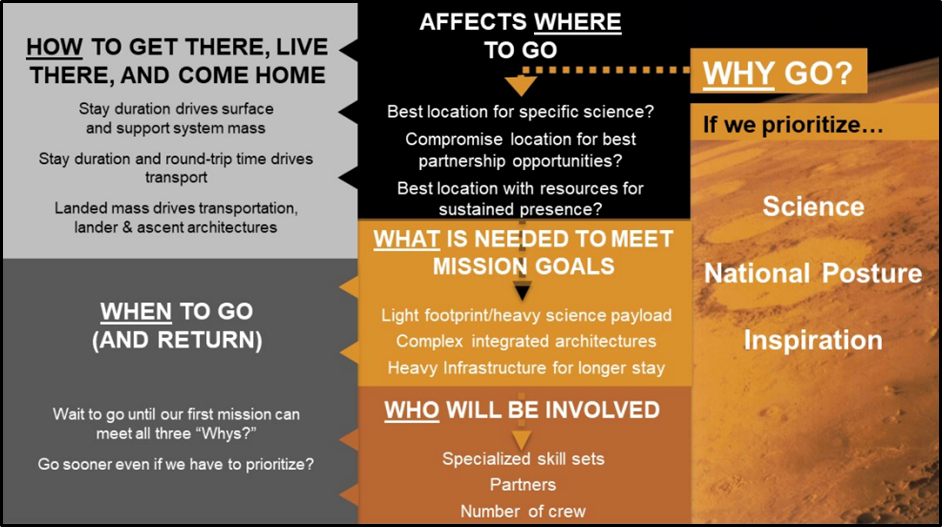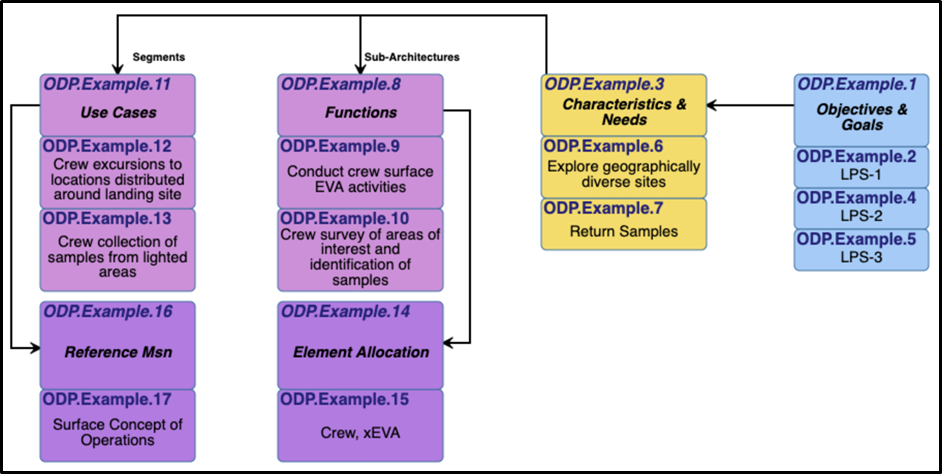2023 Summer Intern Special Webinar
Can't read at the moment? Watch the recording instead!
This summer, I got to research the National Aeronautics and Space Administration’s (NASA) Moon to Mars (M2M) architecture. This project details the continuous plans for exploration of the Moon and human missions to Mars.
It outlines a holistic framework that integrates various components, missions, and technologies to enable and sustain human presence on the Moon. It plans all these moving parts while establishing the foundation for future crewed missions to Mars.
While the primary focus is on the Moon and its lunar capabilities, the Moon to Mars architecture goes beyond that. It also serves as a stepping stone for future missions to get humans on the surface of Mars.
This part of the architecture involves developing and testing technologies necessary for deep space exploration. It leverages international partnerships and commercial collaborations to achieve the ambitious goal of reaching Mars.
This architecture emphasizes an integrated and systems-level approach, recognizing the interconnected nature of the program’s elements. It provides a strategic roadmap that guides decision-making, resource allocation, and the coordination of diverse stakeholders.
As technologies evolve and knowledge expands, the architecture allows for flexibility and adaptation. This ensures the program remains at the forefront of human space exploration.
Experience and expertise gained from previous missions will improve Moon to Mars. M2M is a huge step forward in our journey to explore and understand Space.
Through international cooperation, technological advancements, and sustained commitment to scientific discovery, M2M sets the stage for an exciting era of exploration. This paves the way for humans to venture further than we’ve ever gone before.
NASA answers the question as to why humans should even explore outside of the Earth in their documentation with three pillars. The foundation of the entire architecture lies on the core pillars below:
Each of these pillars contains unique values such as human research, global influence, and careers. All of these culminate to advance leadership and economy and improve the human condition [1].
This project and all the objectives that stem from it will take decades across many different countries, systems, programs, and projects. The goal of reaching Mars highlights steps and processes that are far in the future. This architecture is the first step in achieving that goal.
As technology progresses, NASA can fulfill more objectives and slowly complete steps until the entire system is complete. Currently, however, NASA’s architecture document is an important first step.
An architecture is a high-level structure that explains a system. It provides guidelines, rules, and constraints that define a cohesive and coherent structure. It consists of constituent parts, relationships, and connections that establish how these parts fit and work together.
For the scope of the Moon to Mars project, this architecture establishes the process, framework, and decomposition of objectives. This empowers the executing systems, programs, and projects' success in achieving human exploration of the Moon, Mars, and beyond [2].
In other words, the emphasis is on the overall plan, strategy, and conceptual framework. This is the focus rather than providing specific technical details or numerical specifications for each working component.
To measure the success of this framework, NASA established 9 overarching goals called 'Recurring Tenets' (RT). These tenets give context to why and how NASA should conduct exploration missions. See the 9 documented RTs in the following table.
Table 1. Recurring Tenets Table

NASA assessed each Tenet to determine how well they reflect guiding principles. This assessment also identifies any potential gaps in the architecture, which helps guide future iterations and refinements. All Tenets and their assessments include stakeholder involvement.
The first of the initial assessments is complete for RT-1 with input from appropriate stakeholders with other assessments awaiting future updates. Future revisions to the architecture will continue to track and update the progress of each tenet [2].
Decision drivers are factors or key considerations that influence the design choices and decisions made throughout the development of the architecture. They help guide the decision-making process and prioritize certain aspects over others. NASA splits them up into two categories: Lunar Strategic Assessments and Mars Strategic Assessments.
This section raises many good questions that need answers in the M2M process such as:
· “What foundational capabilities do we need?”
· “Where should the systems be?”
· “How will we get there and return?”
· “When will we achieve lunar objectives?”
· “Who does this approach include?”
NASA has created a diagram that highlights some of these questions with example answers below:

Figure 1. Lunar Architecture Decision Flow Diagram
The Mars decision drivers use a similar style when addressing key questions such as who, what, when, why, and how. It discusses assets at a high level, pointing out what functions they serve and how they will aid in the architecture.
The Mars diagram starts with the three core pillars and then expands to address the earlier questions.

Figure 2. Mars Architecture Decision Flow Diagram
The Moon-to-Mars architecture outlines the overarching goals and objectives of the long-term development. The strategy starts with defining the needs/characteristics for this section.
From a systems engineering standpoint, these needs and characteristics can translate into requirements for each of their respective categories. See the mission categories listed below into different key areas:
Any objective from one of these categories can break down into characteristics and needs. They can go even further and divide into functions and use cases.

Figure 3. Asset Diagram of the General Decomposition of Objectives
The overall M2M mission splits up into 4 different segments:
Each has its own goals and objectives. The segments define a portion of the architecture by one or more integral use cases and progressively increase in complexity. They build off one another using assets and expanding on those assets.
The first segment of the mission is Human Lunar Return. The overall objective of this segment is to reestablish a human presence on and around the Moon. The Human Lunar Return elements are the major system. It is necessary to establish the initial foothold back in lunar orbit and on the surface.
Cislunar space is the area of space near the Moon. NASA will use initial missions to establish early scientific operations in cislunar space on the lunar surface. This includes the curation of samples to return to Earth.
This segment focuses on demonstrating initial capabilities and operations necessary for future operations on and beyond the Moon. The key elements used for this segment are in the following diagram.

Figure 4. Asset Diagram of Human Lunar Return Elements
The respective objectives, use cases, functions, and descriptions of the elements shown in the diagram are below [3]. Find more information on these elements here.
The second segment is Foundational Exploration. It uses the capabilities established in the previous section, initiating new systems to expand mission durations and surface exploration range. This will increase scientific sampling diversity and research in preparing for human missions to Mars.
Foundational Exploration is the starting point for activities and capabilities featured in the Sustainable Lunar Evolution and Humans to Mars segments.
NASA used the same process applied in Human Lunar Return to distill objectives for this segment. They still need to map the functions and use cases to specific elements.
In Sustained Lunar Evolution, NASA aims to build a future of economic opportunity. They can accomplish this through partners and greater participation on and around the Moon.
NASA describes Sustained Lunar Evolution as an “open canvas.” It embraces new ideas, systems, and partners to grow beyond the previous segment.
Increasing global lunar science capability leads to longer stays for more astronauts and researchers. This leads to the large-scale production of goods and services derived from lunar resources.
NASA also stated that it is premature to determine specific elements for this segment beyond the high-level capabilities [2].
NASA’s last mission was Humans to Mars. It is not fully distilled from the M2M objectives to pin specific elements to the first human missions to Mars. However, NASA states that they must study a range of potential mission assumptions to support ongoing analysis for the Humans to Mars segment. This will inform system and technology concepts.
To show an example of potential Mars architecture solutions, they designed some initial assumptions for the body of analysis work. This includes [2]:
Each of the campaign segments contains unique use cases and functions to complete. This section covers those use cases and functions. It also shows how they trace to goals, objectives, characteristics, and needs.
Use cases are operations executed to produce the desired needs and/or characteristics. There are 97 identified use cases within the M2M architecture. Each of them traces to a sub and main architecture entity. See this in the diagram below:

Figure 5. Objective Decomposition Process Example
Functions are actions that an architecture would perform to complete the desired use case. Currently, 121 conducted architectural functions.
As seen in Figure 5, functions are the sub-architecture that will allocate elements to specific equipment for any given objective. Keeping track of and expanding these functions will prove to be vital as the architecture evolves in the future.
I used SPEC Innovations’ full lifecycle solution, Innoslate, to map out NASA's M2M architecture. Our team plans to show this to NASA representatives, showing how they can use our tool for executing the architecture.
I created a conceptual outline of the architecture and how, in theory, they would travel to Mars. This plan is not expected to run immediately. Instead, it explains what humanity should aim for in the next few centuries.
The dashboard of the M2M project in Innoslate provides a one-stop shop for all users viewing the architecture. I summarized the entire architecture so users can simply scroll down and familiarize themselves.
The Project Dashboard provides glimpses into different areas of the architecture. They can read from there and get the top-down story. They can also click on a document or diagram to get more information.
All documents and diagrams reflect what is in the original NASA document. The dashboard tells the entire story so users won't have to scroll through all the documents and diagrams themselves.
I have also worked on the database, more specifically, the queries. Queries are a way to store specific information in the database and get to it in one click.
I have saved different pieces of information including original figures, functions, and use cases in different queries. This way, a user could access them quickly if needed. I did this using the labels feature in Innoslate.
I labeled everything stored in the database so I could sort and filter them with queries. This makes it easy for users to find any specific information at a glance. There’s no need to manually go through the database themselves.
To view this project, download the .inno file and upload it through the Import Analyzer.
It was a daunting task to examine this architecture and document diagrams and key concepts along the way. However, it was a rewarding task as well. It’s exciting to see what becomes of this in the future as technology becomes better.
There can be several lessons learned from NASA’s architecture. The first would be to take a holistic approach to any problem. This allows you to fully see the complex relationships between components and to gain a better understanding. Decomposing the systems down into interactions between components makes adjustments and improvements easy and efficient.
Another lesson learned is how to take a “right to left” approach to projects which has many advantages. This approach applies to the quote by Dr. Stephen R. Covey, “Begin with the end in mind.” This works best for an architecture of this magnitude.
One more apparent lesson is to plan, even if there is no built system. Technology may not be at the needed level, but you can carefully and holistically plan with a systems engineering approach.
To offer some feedback, lean more into the assets and technology that are available now and describe them in greater detail. Describe how to expand these systems further to accomplish future milestones.
Alternatively, if a system retires in the future, describe to what extent you utilize the legacy system. Explain how the retirement is in lieu of a better newer system.
We stand on the horizon of a new era of human space exploration. This architecture, with its integrated framework, strategic roadmap, and grand vision represents a monumental step toward. It unlocks the mysteries of the cosmos and expands the horizons of human knowledge.
By establishing a sustainable presence on the Moon and setting our sights on Mars, we open doors. These doors lead to scientific breakthroughs, technological advancements, and the potential for future human settlements beyond our home planet.
This architecture showcases the power of human determination. It proves the collective spirit that unites nations in the pursuit of a common goal and the relentless pursuit of innovation.
It ignites the imagination of future generations, inspiring them to reach for the stars and embrace the spirit of exploration.
Innoslate offers a seamless solution for managing your systems engineering lifecycle. Create diagrams just like the ones above and so much more.
[1] NASA, “NASA’s Moon to Mars Strategy and Objectives Development,” M2M Strategy and Objectives Development, https://www.nasa.gov/sites/default/files/atoms/files/m2m_strategy_and_objectives_development.pdf (accessed Jun. 1, 2023).
[2] K. Goodliff et al., “Moon-to-Mars Architecture Definition Document,” Exploration Systems Development; Mission Directorate, https://ntrs.nasa.gov/api/citations/20230002706/downloads/M2MADD_ESDMD-001(TP-20230002706).pdf?attachment=true (accessed Jun. 1, 2023).
[3] D. Galarza, “Human Lunar Return Campaign Segment Elements,” Innoslate, https://cloud.innoslate.com/spec/p/1343/diagrams/asset/463623 (accessed Jun. 22, 2023).
Have questions about model-based systems engineering or requirements management? Talk to an expert and see how Innoslate can streamline your projects from start to finish.
.png)
Can't read at the moment? Watch the recording instead!
Leaving your old tool might seem daunting, but Innoslate is a modern, cloud-computing tool that makes moving your data simple. The transition process...

In today’s business landscape, organizations are constantly seeking a competitive edge that enhances their efficiency and quality to drive new...